Gelato wars: My five favorite gelaterias in Rome
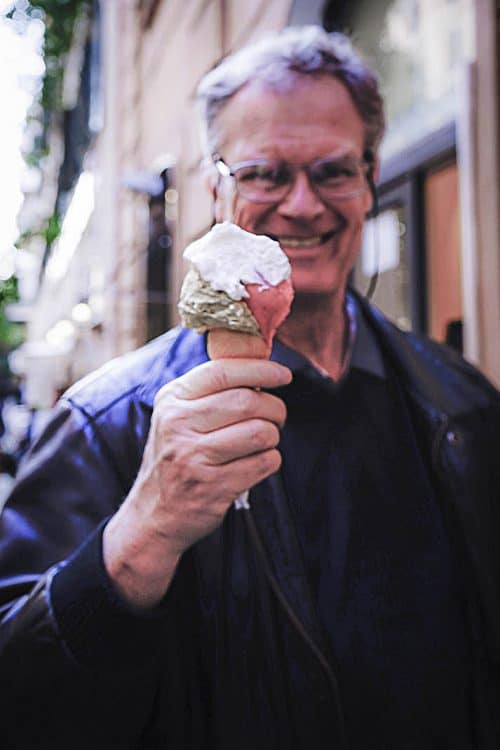
It was my birthday Thursday and what’s a great way to spend your birthday week in Rome? How about eating gelato every day? You can do that here. Sure, you can do that in Nebraska, too, but soon you’ll look like most of the people around you. Here in Rome gelato is considered one of the four major food groups, along with wine, pasta and local politicians. Like everything else in Italy, gelato is all natural, as pure as the olives in olive oil and grapes in wine.
I’ve done this before. When I lived in Rome the first time from 2001-03, I wrote a major tome about gelato for SilverKris, Singapore Airlines’ inflight magazine. I roamed the city on hot summer days, tasting gelato, interviewing gelateria owners, interviewing panting customers from around the world. Hey, it beat covering Iraq.
As one English tourist told me as she ate a large tub of nocciolo (hazelnut), mirtilli (blueberry) and caramel creme, “Is gelato ice cream or a Roman god?”
Good question. So cold. So sweet. So good. Why is gelato Italy’s favorite food?
It is Italy’s lunch break, its afternoon snack, its nightcap. Softer than industrialized ice cream you find in the U.S. and harder than soft ice cream spit out from machines in restaurant chains, gelato has the perfect velvety texture. In a country built on art and driven by romance, gelato is the fuel that ignites the masses. It also unites them. Strolling the cobblestone passageways snaking off Piazza Navona or in front of the 2nd century Pantheon, romantic Romans can’t seem to hold their lover’s hand without holding a gelato in their other one.
“When you eat a cone, it is love,” said Nazzareno Giolittli, owner of Giolitti, the hugely popular gelateria near the Pantheon. “It’s not possible for American people to walk along the street because it’s too frantic. Rome, it’s more slow. It’s a tradition to walk around the city. When old people look at ice cream, they become young again.”

And I’m old. I turned 62 Thursday. But as I licked my way across Rome this week, I felt the same as I did when I first came to Italy and had my first gelato in front of the Duomo in Milan. I was 22. I’m firmly convinced if I keep eating gelato in Rome I’ll be young forever.
I don’t have to go far to find it. According to Bloomberg Markets, Italy has 19,000 gelaterias which in 2016 sold 157 million gallons. That equates to 6.8 billion scoops. Italians eat an average of 100 scoops a year for a total annual sale of more than $1.7 billion. According to Confcommercio, the gelateria industry employs 69,000 people. Considering Italy is going through its biggest recession since World War II, the gelato industry in Italy is as important as the auto industry in Detroit, except you get more mileage out of gelato.
The key is finding the right gelateria. Gelateria owners — or gelato jockeys as I call them — I talked to and my own mouth-watering wanderings over the years estimate that only about 20 percent of the gelaterias are natural. The rest are industrialized frauds using artificial ingredients and coloring to make the flavors look more inviting. As a result, their gelato is as inviting and real as the hookers flirting behind the windows in Amsterdam.
Want a tip? It’s easy. If the gelato is big and puffy and bright, it probably has more artificial ingredients than a small jet engine. Air creates that puffiness. And if the banana flavor is bright yellow and the pistachio bright green, keep walking. Think about it. Both fruits are kind of grayish. Real gelaterias present their gelato flattened in tubs. The ingredients are concentrated, real, natural.
Even healthy.
Yes, natural gelato is not real fattening. One hundred grams of gelato, depending on whether its fruit or cream based, is between 100 and 200 calories. One hundred grams of Cherry Garcia, one of Ben & Jerry’s most popular flavors, is about 300 calories. Also, eating an American ice cream cone isn’t the same when you’re walking around a suburban strip mall.
Cream flavors consist of egg yolks, milk or cream, sugar plus whatever flavor, be it chocolate or hazelnut or whatever. Fruit flavors consist of water or milk, sugar and fresh fruit. The real gelaterias change flavors with the season. You won’t find mango in January; you won’t find pear in July. It’s spring and fragole (strawberries) and lamponi (raspberries) are starting to return.
I remember Pasquale Allongi, owner of San Crispino, which The New York Times once called the best gelateria in Rome, flew in grapes from Chile. For his coffee flavor he used Blue Mountain coffee from Kenya. For his zabaione (marsala custard), he used marsala aged 25 years.
What do the industrialized gelaterias use? Picture a gelato jockey opening a bag.

“It’s faster,” said Gianluciano Mereu, owner of Old Bridge, my first favorite gelateria dating back to 2001. “For example, to do lemon or orange gelato, I must squeeze 20 kilos of oranges and lemons to make five liters of juice. They just open a sack and pour in powder for a few seconds. That’s the problem. It’s disgusting.”
Meanwhile, American ice cream is packed with vegetable fats for longer shelf life. What results is the shelf life of Ivory soap. The vegetable fats make it so hard, you not only can serve it with a knife and fork, it’s advisable.
However, gelato does owe something to the American ice cream industry. The ice cream cone was invented at the 1904 World’s Fair in St. Louis. At the time, ice cream had been in the U.S. since 1851 when it came to Baltimore and stabilizers were used to freeze it faster.
By that time, gelato had been in Italy for about 2,000 years. Arabian Sarazens brought to Sicily iced fruits known as sherberts which comes from the Arabic word sharba, meaning “fresh ice.” During the height of the Roman Empire, the Roman aristocracy often relaxed with a form of gelato made from fruit puree, honey and snow. They’d pack snow from Mt. Tolfa in the nearby Anti-Apennines mountains and carry it to Rome, using fresh horses every few miles.
Consequently, it was only a winter dish. Today, gelato is the Italian food of choice all year round. Emperors and paupers, senators and actors, English teachers and retired journalists.
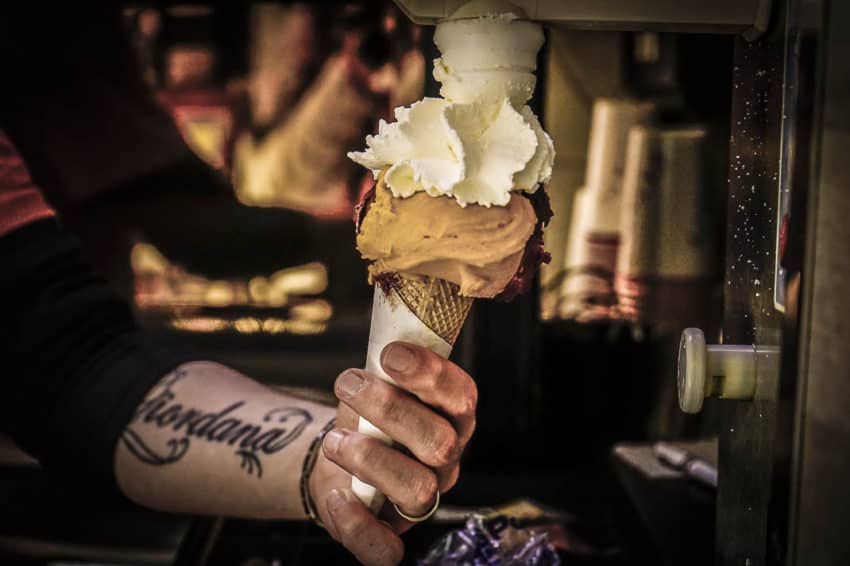
Another major aspect that sets apart Italian gelato is the panna (whipped cream). They all give it free, a big fat white fluffy dollop on top and it’s mostly handmade, not the Reddi Wip for which my old faux pas gelateria in Denver charged $1.50. It adds a creamy touch to the palate, not to mention a good excuse to lick your date’s nose when she misses.
Panna, however, can get you into trouble. It once got me thrown out of a gelateria. True story. Some guys get thrown out of bars in border towns. Some get thrown out of political rallies. I get thrown out of an ice cream parlor. I was at Giolitti’s first store, in my Testaccio neighborhood. An old crusty owner served me a cone and asked me if I wanted panna.
I said, “Of course. Gelato without panna is like sex without an orgasm.” I thought it was funny. Most gelato jockeys laugh, especially the women. He scowled, pointed at the door and said, “VAI VIA! (GO AWAY!). I wasn’t mad. I didn’t blame him. The guy probably hadn’t had an orgasm since Mussolini was hanging from his toes.
I recalled that story this week but something else hit me. If I’ve lived here 5 ½ years and am a regular gelato junkie, I need a top five list, one I can send to friends who need recommendations. Old Bridge is the only one that survived the test of time and never left the ranking, kind of like Duke basketball or Beyonce. For help, I blasted an email on my Expats Living in Rome Meetup website and asked for everyone’s favorite gelateria. I received more than 70 responses totaling 30 different spots. While I did my best to hit each one, I came up short before I started just injecting the black cherry gelato straight into my arm.
I used the survey as a research guide but mostly used my own past and taste for my top five gelaterias of Rome. They are all small. They are all inconspicuous. They are all authentic. And they will spoil you forever:

1. Brivido, (Neighborhood: Testaccio), Via Giovanni Battista Bodoni 62, Monday-Saturday 11 a.m.-1 a.m., Sunday 11 a.m.-11 p.m.
Living five minutes away, I’ve made Brivido my nightcap. It’s cheaper than another glass of wine and much healthier. Although purists can argue that getting the free dip into big vats of white and dark chocolate isn’t healthy or traditional, I’m not traditional, either. Biting into a hard, white-chocolate coating and sinking your tongue into soft, creamy flavors of all natural ingredients is my idea of ending the day.
My favorite flavor, amarena (black cherry), is especially good here as they use raw cherries. I loved the new flavor I tried this week, arachide (peanut). Brivido also has a whole line of vegan flavors.
Since 1986 it has occupied a quiet street corner in my Testaccio neighborhood just a block from legendary Piazza Testaccio where you can now find fathers and sons playing soccer around the giant fountain. Owner Mady Amodeo laments how the spread of industrialized gelaterias in Rome has contributed to the fall of mankind, pointing to her pasteurization machines behind the display window to show the work she puts in every day.

2. Old Bridge, (Prati), Viale dei Bastioni di Michelangelo, www.gelateriaoldbridge.com, 10 a.m.-2 a.m. Monday-Saturday, 2:30 p.m.-2 a.m. Sunday.
This is extraordinarily biased as I’ve been going here for 17 years. Even between Rome habitations, I made beelines here on vacations. It’s a tiny shop with no tables or chairs just west of massive Piazza del Risorgimento. On sunny days Old Bridge is in the shadow of the Vatican wall.
I’ve always liked Old Bridge because of its portions. They’re the largest in Rome but do not sacrifice their natural ingredients.
“Since we opened 30 years ago, we try to use two components: the quality and the quantity of the product,” Mereu said. “We always thought that these two things together are fundamental for the success of our work. So we prefer to earn a little less but we give something more to our clients. It’s our philosophy to thank them.”
Like many gelaterias, Old Bridge goes to great lengths for its natural products. For its most popular flavor, pistachio, Mereu gets pistachios from Sicily near a volcano where the earth is richest. “They’re the best pistachios in the world,” he said.
Another Old Bridge has returned to Trastevere at Via della Scala 70.
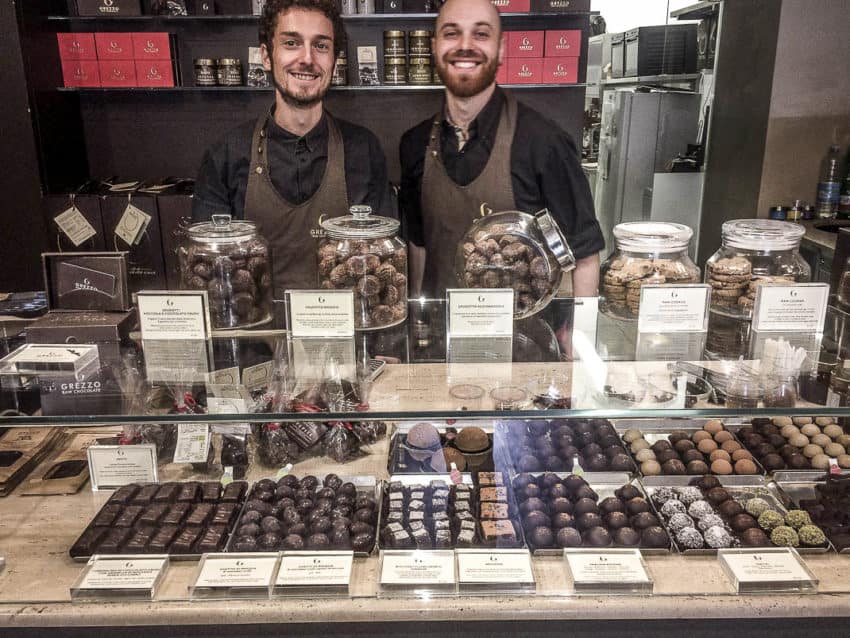
3. Grezzo, (Monti), Via Urbana 130, www.grezzoitalia.it., Monday-Saturday 11 a.m.-midnight, Sunday 11 a.m.-11 p.m.
Matteo Mercolini, 28, became a vegan four years ago and did plenty of research on the health benefits and diet. Ironically, Grezzo opened four years ago in an inconspicuous shop in Monti, arguably Rome’s hippest, liveliest neighborhood today. It’s not so ironic that Mercolini took a job here slingin’ gelato two weeks ago.
“After I taste this my conception of gelato totally changed,” he told me. “I can not go to any other ice cream shops.”
Mine changed here, too. Grezzo is famous for its raw chocolate, and its display case is filled with tantalizing little chocolate chunks filled with everything from pralines to various nuts. Occasionally I’d drop by to buy my girlfriend, Marina Pascucci, who took most of these photos, a little gift box and a piece for myself. While I swooned in my own chocolate-infused sexual ecstasy, I never thought about trying the gelato. It has become Grezzo’s side venture, along with its cakes and cookies.
But Grezzo received some votes in my survey and a friend urged me to give it a chance. My friend was right. The chocolate, the raw chocolate gelato, was the best chocolate ice cream I’ve ever had. The chocolate beans are sun dried, not toasted like most places. So concentrated, the chocolate exploded in my mouth. I paired it with nocciola (hazelnut) which is 40 percent nuts compared to the usual 20 percent, Mercolini said.
“Keeping the process under 42 degrees, it allows us to maintain all the nutritional values and, of course, the flavor is more powerful,” he explained. “It’s more concentrated in the mouth.”
I look forward to this summer when they break out their mango, raspberry, blueberry and passion fruit, which match the chocolate in popularity.
Started in Turin, Grezzo will open a shop in Centro Storico near Largo Argentina at the beginning of May.
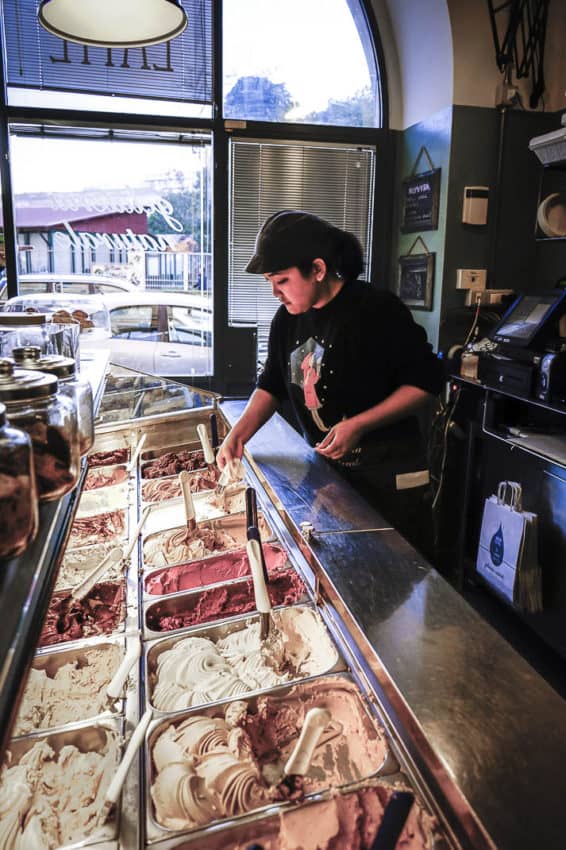
4. Neve di Latte, (Flaminio), Via Luigi Poletti 6, Monday-Friday noon 10 p.m., Saturday noon-11 p.m., Sunday noon-10 p.m.
Besides receiving multiple votes, it received the biggest vote from Alessandro Castellani, my sportswriter buddy and patron saint of Italian food and wine recommendations. Again, Castellani hit the bull’s eye. Sitting on a side street behind the MAXXI modern art museum in northern Rome, Neve di Latte looks anything but touristy. Its bland gray and white interior makes it look older than its eight years and there’s nothing fancy about the flavors.
But the gelato I had — pistachio and variegato (cocoa, hazelnut, cream) — was spectacular. You could actually taste the cream separate from the cocoa and hazelnut. How serious do gelaterias take their ingredients? Neve di Latte gets its milk and cream from a biodynamic producer in Germany where the cows graze at about 4,600 feet. Its Amadei chocolate and Parisi eggs are from Tuscany. La Stampa newspaper merely called the Parisi egg “the most delicious egg in the world.”
Underneath it all, the pistachio was as good as any I’ve ever had and I’ve tried it all over Italy.
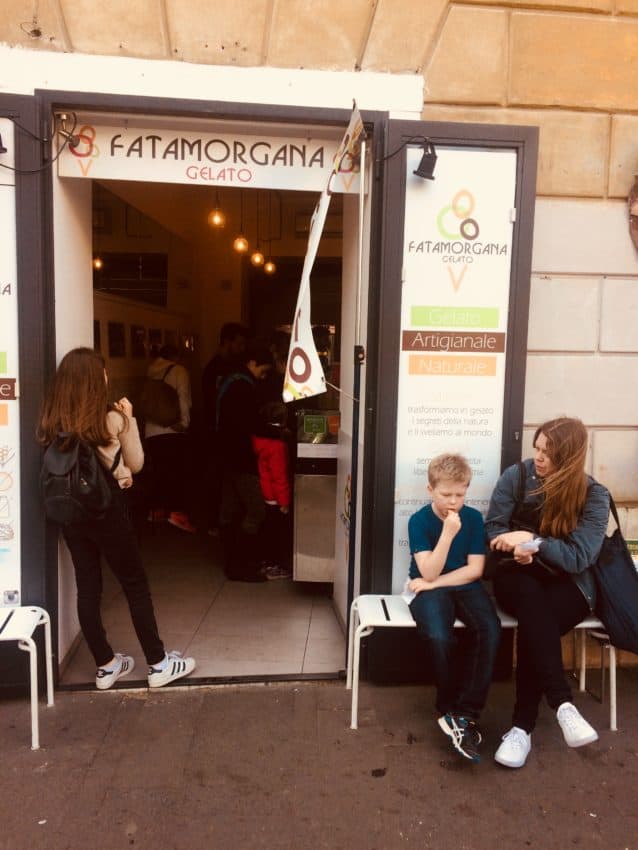
5. Fatamorgana, (Trastevere), Via Roma Libera 11, www.gelateriafatamorgana.com, daily noon-1 a.m.
I had my top five set — until I came here on my birthday. It makes the list purely by its adventurous nature. Yes, as the sign says, it is also gluten free, egg free, milk free, nut free, sugar free. OK, we get it. But it’s also tradition free.
Fatamorgana, although part of a chain that’s always a red flag, has the most interesting flavors in Rome. On my visit I saw carrot cake, baklava, Lapsong Sonchong (a Chinese smoked tea) chocolate, blackberry and grapes. I’ve read about such flavors here as cinnamon-apple-nut, tiramisu and blueberry cheesecake. One called Bacio del Principe (Kiss of the Prince) is made of gianduja (a chocolate paste made from ground hazelnuts). Panacea is almond milk, ginseng and mint.
I had its famous banana cream with sesame brittle and the sesame’s salt adds an intoxicating flair to the sweet banana. I combined that with seadas:, pecorino cheese from Sardinia, chestnuts, honey and orange peel. You could taste every ingredient, kind of like a fine wine.
The mastermind behind all this is Maria Agnese, a country girl who made gelato as a child but never followed a recipe. She once used leaves from a local orchard’s almond tree and invented almond flowers gelato cream.
There are also stores in Monti, Re di Roma, Corso and North Rome.
Keep in mind, just like basketball rankings, gelato is a matter of taste, in more ways than one. Below is my survey results (with neighborhood in parentheses). Please note the many votes for LaRomana. It’s good but it did not make my list.
Fatamorgana (numerous locations) 8
LaRomana (numerous locations) 8
Fassi (Equilino) 6
Gracchi 4 (Prati)
Neve de Latte (Flaminio) 4
Grezzo (Monti) 4
San Crispino (Centro Storico) 4
Old Bridge (Prati, Trastevere) 3
Frigidarium (Centro Storico) 3
Giolitti (Centro Storico, Testaccio) 3
Brivido (Testaccio) 2
Guttilla (Monte Sacro) 2
Pico Gelato (Piazza Bologna) 2
Angelletto (Monti) 2
Millenium (Prati) 1
Rivareno (San Giovanni) 1
Cremeria Aurelia (Aurelia) 1
Siciliana (Prati) 1
La Strega Nocciola (Spagna) 1
Vecchi (Centro Storico) 1
Olive Dolci (Manzoni) 1
Like G (Prati) 1
Otaleg (Portuense) 1
Gelateria del Teatro (Centro Storico) 1
LaPalma (Centro Storico) 1
Ping Pong (Tuscolana) 1
Cremi (Trastevere) 1
Ciuri Ciuri (Quirinale) 1
Quinto (Centro Storico) 1
Tony (Portuense) 1


April 4, 2018 @ 11:09 am
Will absolutely be trying these on my next trip. Thanks for sharing!
April 11, 2018 @ 5:30 am
Wow, how crude you are! Was intending to post a link to this on my travel blog, but if you think it’s “funny” to compare ice cream to sex while talking with total strangers… my travel-clients would be just as appalled as I am.
April 11, 2018 @ 6:18 am
Well, Walt, it sounds like you’ve never experienced an orgasm. Maybe if you developed a sense of humor that might change.
July 25, 2019 @ 5:32 pm
hi
john, try gourmandaise in via felice cavallotti in monteverde…..
thank you for your list…
piero
July 27, 2019 @ 2:20 am
It’s not near me but I’ll try it. Thanks!
July 29, 2019 @ 6:27 am
I agree with Piero, La Gourmandaise is sensational!